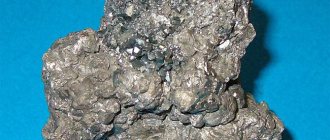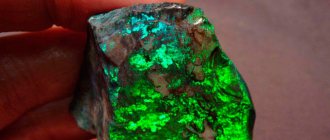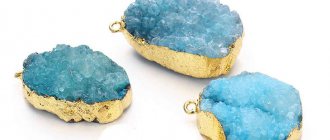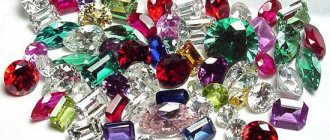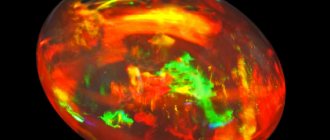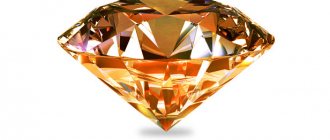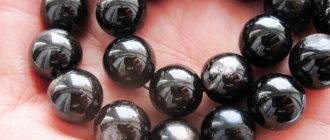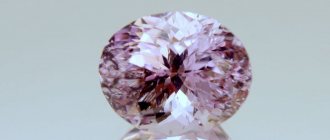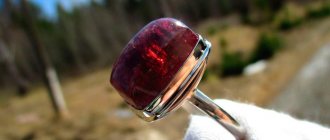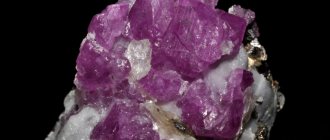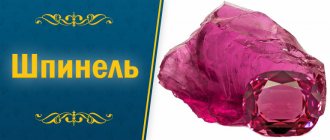From this article you will learn what stones are blue and light blue.
In the photo: precious sapphires from Sri Lanka
Precious and “semi-precious” stones of blue and cyan colors are among the most popular in Russia, and in the world as a whole. This color is traditionally perceived as calming and is often identified with the color of the sky or sea. Note that blue is quite rare in nature, therefore gems of this color are usually among the most valuable and expensive. In this article we will look at several well-known names, as well as more rare ones.
Find out about the main cause of color in gemstones and its main components in our article on DK color.
Precious blue stones
Precious stones are rarely found in nature. Used to make jewelry. In our country, 7 minerals are classified as precious stones. Only 2 of them can have a cornflower blue hue:
- Blue diamond is a very rare stone, the cost of which starts from 10,000,000 rubles per carat. The natural mineral is mined only in South Africa and no more than 1 copy per year.
- Sapphire is a cornflower-blue gem, a type of corundum. The price of natural stone starts from 20,000 rubles per carat. Sapphire is able to protect its owner from envy, deception, improve financial condition, and bring good luck.
Why are such gems valued?
Blue stone is chosen for many reasons:
- Jewelry with blue accents or stones of such shades indicates a developed aesthetic sense and taste of the owner.
- Blue color is a traditional attribute of wealth and power.
- It is preferred by those who clearly know what they need from life and how to achieve it.
- He embodies composure, calmness even to the point of tranquility.
Blue stones in jewelry never look tacky, vulgar or gloomy.
On a subconscious level, blue is associated with a cloudless daytime sky or the mysterious period of day preceding twilight.
Semi-precious blue minerals
Semi-precious stones are minerals from which jewelry is also made, but they are much more common in nature and are not rare.
Among the semiprecious stones of cornflower blue color, the following specimens can be distinguished:
- Blue chalcedony (sapphirine) is a mineral of light blue, azure shades, which has a matte or translucent structure. It is able to endow its owner with calmness, patience, give longevity, and find love. The cost of 1 carat chalcedony starts from 6,000 rubles.
- Turquoise is a gem that can change its shade depending on age. The young stone has a light, almost white color, then becomes sky blue (the most valuable specimen), and then greenish. This is an opaque sample with veins and inclusions, 1 carat of which costs 1,500 rubles. Protects the owner from various types of injuries and brings good luck in trading.
- Lapis lazuli (heavenly stone) is a dark cornflower blue gem with white or purple inclusions. Lapis lazuli is a feminine stone that restores hormonal levels and helps to bear and give birth to a healthy child. Lapis lazuli size of 1 carat costs 300 rubles.
- Aventurine is an opaque cornflower blue mineral with golden veins and sparkles. It is the strongest protective talisman, enhances the positive qualities of the owner, gives good mood and clarity of mind. Aventurine of 1 carat size costs 300 rubles.
- Aquamarine is a transparent, heavenly-colored crystal that looks like a piece of ice. It is able to change its color depending on the viewing angle from light blue to bright blue. The gem has a beneficial effect on the cardiovascular system. The cost of an aquamarine weighing 1 carat is from 4,000 rubles.
- Benitoite is a rare transparent mineral from blue to dark cornflower blue with pronounced pleochroism, similar in appearance to sapphire. It helps you build a career, become famous in your field, and gain recognition. The cost for 1 carat is about 65,000 rubles.
- Kingfisher jade is a variety of sky-colored jadeite, the main deposit of which is located in Guatemala. Its cost per 1 carat is about 10,000 rubles. It is believed that jadeite brings happiness to the owner.
- Iolite is a natural imitation of sapphire, a transparent gem of a cornflower blue or violet hue. Improves family relationships, calms the nervous system, helps in the treatment of mental illnesses. Price – about 1000 rubles per carat.
- Girazole is a transparent variety of blue opal. Peruvian opal is an opaque sea green mineral. Cost – from 10,000 rubles. The gem is capable of maximizing the talents of its owner.
- Blue quartz teaches you to accept the situation and easily pass the tests that fate presents. Price – from 500 rubles.
- Tanzanite is a variety of zoisite, a representative of a dark blue, violet, purple hue. They are mined only in one place - Tanzania. Price – 27,000 rubles per 1 carat. It has strong pleochroism and pronounced alexandrite effects (changes color depending on lighting). Tanzanite influences the internal development of a person and reveals awareness.
- London Blue Topaz is a variety of topaz that looks like the evening sky, obtained by irradiating blue topaz with neutrons. Price – from 1000 rubles per carat. It is a stone of optimism, friendship, spiritual purity and joy.
- Tourmaline - has different shades, there are 2 blue varieties: cornflower blue elbaite and dark blue indigolite. A mineral of spiritual development that helps develop consciousness and creativity. Price – from 4000 rubles per carat.
- Starlite is a bright cornflower blue variety of zircon. Promotes the development of memory and observation skills. Price – from 4000 rubles per carat.
- Spinel - has different shades, including blue. Spinel protects the human soul from demons and purifies thoughts. Cost – from 50,000 rubles.
- Irnimite is a type of jasper of heterogeneous texture of a cornflower blue hue with colored veins and spots randomly located on the surface of the gem. Price – from 6000 rubles per carat.
To view the photo gallery:
Blue chalcedony
Turquoise
Lapis lazuli
Aventurine
Benitoite
Kingfisher jade
Iolite
Girazole
Blue quartz
Tanzanite Starlite
Spinel
Irnimit
Aventurine in products and jewelry
The most famous product made of aventurine (light color) is a bowl located in the Hermitage Museum (St. Petersburg). The height of the product is about 150 cm, the width is about 250 cm. The bowl was made by Ekaterinburg stone-cutters in the 20s of the 19th century. Rising on a pedestal in the center of St. George's Hall, the bowl gives a special solemnity and monumentality to the room.
Processing the stone in the form of a cabochon or cutting aventurine products undoubtedly enhances the aesthetic perception of the product. Cutting the mineral into silver, cupronickel (an alloy of copper, most often with nickel) adds beauty and grace to earrings, pendants, and rings. Beads of faceted or round shape enhance the effect of richness and completeness of the product.
How to distinguish natural stone from fake?
Recently, quite a lot of crafts and jewelry have been produced, and of high quality, based on synthetic aventurine. Even in photos of products in advertising brochures and on websites, the bright and thick color, shine and shimmer catches the eye. Cabochons (smooth stones with a convex surface processed in a special way) and jewelry based on synthetic aventurine often look more impressive than natural ones, while having a relatively low cost.
There are several simple techniques and rules for distinguishing an original from a fake:
- Due to the medium hardness of aventurine, it can be cut with a diamond cutter, which will leave a line.
- Aventurine scratches glass, but fakes do not.
- Natural stone has an uneven surface, with less pronounced color and shine of inclusions. The internal shimmer of natural aventurine is also less pronounced.
- And, most importantly, the dark blue stone is a fairly rare mineral with a corresponding price. Therefore, products made from real gems cannot be cheap.
- The healing and energetic effect in the artificial gem is completely absent.
Decorative and ornamental blue crystals
Ornamental minerals are the least valuable stones that are used to make decorative items or jewelry.
- Onyx is an ornamental gem from which bracelets, beads, candelabra, and photo frames are made.
- Dumortierite is a light blue mineral used to produce high-quality porcelain, souvenirs, and jewelry.
- Kyanite is a cornflower blue or violet-blue gemstone, widely used in industry or for creating decorative items.
- Azyrite is a natural imitation of lapis lazuli, used in jewelry.
- Cubic zirconia, moissanite are artificial imitation of diamonds, including blue ones.
- Alpanite is a cornflower blue mineral that is used to make jewelry.
See photos of stones:
Onyx
Dumortierite
Kyanite
Azyrit
cubic zirconia
Alpanit
WHO IS SUITABLE BY ZODIAC SIGN?
According to the horoscope, the blue aventurine stone is suitable for everyone, but the degree of impact of the mineral depends on the zodiac sign of its owner:
| ARIES | It will help the impulsive and stubborn Aries to extinguish selfishness, bring what he started to completion, and add sensitivity to family and friends. |
| CALF | For an indecisive, obstinate, but friendly Taurus, aventurine will give prudence, warn of danger, and lift the spirit. |
| TWINS | Charming but changeable Gemini should wear a bracelet with blue aventurine as a talisman to attract good luck and love. |
| CANCER | For the romantic and fickle Cancer, the blue stone will give endurance and awaken vigilance, help resolve important issues and provide support in matters of the heart. |
| A LION | It will protect the ambitious fiery Leo from all sorts of troubles, attract prosperity, protect him from poverty and give him longevity. |
| VIRGO | For a pure and immaculate Virgo, the blue mineral will relieve suspiciousness, clear the mind, bring good luck and cleanse the aura. |
| SCALES | Libra will attract romance and love, and will relieve suspiciousness and bad thoughts. |
| SCORPION | It will bring good luck to a risk-taking Scorpio in a game or business, enhance insight, and help achieve any goal. |
| SAGITTARIUS | It will give Sagittarius peace of mind, protect against rash decisions and maintain health. |
| CAPRICORN | For Capricorn, a blue gem will become an assistant in business, strengthen intuition, and add optimism. |
| AQUARIUS | Considered a stone of good luck for Aquarius, it especially favors the female sex. |
| FISH | It will protect Pisces from the evil eye, improve health, and bring good luck in business and romantic relationships. |
We recommend: MOONSTONE - the magic of the night luminary
Blue aventurine is capable of, if not completely changing the life of its owner, then adjusting areas that require attention.
Text author: Varvara STOLYAROVA
Sacred Blue Stone
On the territory of Russia, on the shore of Lake Pleshcheevo in Pereslavl-3alesky, there is a sacred blue stone, which is about 2000 years old. This 12-ton gray boulder turns blue after rain (the surface is made of biotite and quartz, which change color when they absorb water).
They tried to get rid of the boulder several times. In the 18th century it was buried in the ground, but it ended up on the surface (external waters washed away the ground).
In the 19th century, it was planned to be used for the construction of the Spiritual Church and was transported across the lake on ice. The ice could not stand it, and the stone fell underground. However, after 70 years he found himself on the surface again. Over time, as a result of geological processes, the boulder began to go underground.
Since ancient times, people have turned to him to make a wish and gain health. To make your wish come true, you should bring a gift (a coin) to the stone and tie a ribbon on the tree closest to it, which is sold in souvenir shops near the boulder.
Therapeutic effect
Therapeutic “specialization” of minerals of the celestial range:
- neutralization of emotional stress, depression or aggressiveness;
- ensuring healthy, sound sleep;
- help with heart ailments, hypertension, asthma;
- normalization of metabolism, gastrointestinal tract function;
- treatment of skin pathologies.
The main mission of blue stones, according to psychologists, is to radiate calm, to tune a person into a philosophical attitude towards the vicissitudes of life. This is a talisman against phobias and nightmares.
As a result of the peace of mind given by blue stones, the immune system is strengthened.
It is advisable that when worn, the stones in jewelry come into contact with the body.
Healing and magical properties of blue stones
Cornflower blue stones have several common properties that are characteristic of both ornamental and precious representatives.
They help get rid of dissatisfaction with your own life, discover extrasensory abilities, and improve your creative abilities. They also protect against other people’s magical interference: the evil eye and damage.
They also have medicinal properties:
- help with cardiovascular diseases;
- reduce blood pressure;
- strengthen the immune system;
- have a beneficial effect on the psycho-emotional sphere;
- treat skin diseases (eczema, allergies, psoriasis).
Blue gems are suitable for air and water zodiac signs. For women with the names Nadezhda, Svetlana, Victoria, for men - Peter, Boris, the gem will bring good luck and financial well-being.
To watch a video about the properties of some stones:
HOW TO DISTINGUISH STONE FROM GLASS
Natural blue aventurine is rare, so if the stone is exactly this color, then most likely it is a fake.
| + | – |
In a real mineral:
| In aventurine glass:
|
The artificial material is made by melting glass with the addition of copper or iron filings.
Another difference is hardness: while natural aventurine has a 7 on the Mohs scale, glass has a 5.
Ural mines
If the fake is more beautiful than the original, and even in a gold frame, then why not wear it. Another thing is that it will not have healing and magical properties.
Onyx and others
Stone from the Bible
Another quartz chalcedony with a fibrous structure is onyx. This stone is characterized by brown, black, white, pinkish layers. There is also a mixture with yellow and red colors. The color is so strongly attached to the name that even striped marble is often called onyx (Algerian or Mexican).
People's respect for onyx was shown by the entry in the Bible that speaks of Paradise, and the richness of the earth is emphasized by the presence of onyx. The best deposits are located in Arabia, Brazil, and on the Hindustan Peninsula. Read about all the qualities of the mineral in the article “What does onyx stone look like and its properties.”
Iron painted
Acquaintance with the types of chalcedony continues with carnelian, which is characterized by pink, red and orange tones. These same colors plus white often give a striped appearance. The peculiarity of coloring lies in the distribution of pigmenting microparticles. The main dye is hematite with a high iron content.
The main deposits of carnelian are located in Crimea, India and Montana (USA). When exposed to bright light for a long time, the stone brightens, dark brown minerals become bright orange. The resulting color is the best for making jewelry, cameos and gems framed in gold.
Useful connections with onyx
During the time of the pharaohs, the Egyptians made clasps from carnelian in the shape of a trefoil, thereby placing themselves under the protection of the goddess Isis. Amulets with it were worn on the chest, considering it a sure cure for bleeding. There are agates painted to look like carnelian on the market. You can identify a fake by splitting a stone. The paint layer does not go deep inside, it stays at a level of 1-2 mm.
Sardonyx is a variety of carnelian, where the stripes are arranged in parallel. The name suggests a connection with onyx, the banded species of which are called carnelian and agate. Both are valued as ornamental stones. The layers are composed of chalcedony, quartz, and opal, which does not belong to this “family” of stones.
Little familiar stones
Among other varieties of chalcedony we name:
- light turquoise endrigus;
- moss moss with “pieces of moss” hidden in a transparent haze of the main color;
- chrysoprase with a rich emerald tint due to the presence of nickel;
- sarder (brown tones with red additives);
- mtorolite with green stripes of varying intensity;
- grape from Indonesia (exotic lilac color).
Ancient man became acquainted with chalcedony when he began to make arrowheads and spears using flint stone. With its help they made fire by striking sparks.
The surface of the tiger eye stone is silky, with stripes of golden yellow, brown or black. And this is another striped type of chalcedony.
Connected by the same composition
The numerous genus of chalcedony includes more than a dozen gems. All belong to the quartz group. They are used as materials for inserts into rings, earrings, pendants, for the manufacture of bracelets, beads, decorative dishes, vases, and caskets.
Common to all stones is a density of around 2.6 g per cubic meter. cm and hardness varying from 6.5 to 7 units. As well as the chemical composition, which is expressed as SiO2 - silica. This is the formula for chalcedony. You will find other details in the article “Who is chalcedony stone suitable for and its properties.”
Let us list the gems common in the jewelry industry that are associated with chalcedony by the above characteristics:
- agate;
- sapphirine;
- jasper;
- heliotrope;
- onyx;
- cornelian;
- sardonyx;
- chrysoprase.
Some of the listed stones are striped. Below we will consider each chalcedony representative separately.
Nemongo about Aventurine
Natural blue aventurine is very rare today. More common colors are dark green and dark brown. The only deposit of the stone is in India, near Jampur. The color palette is determined by the percentage of inclusions. Stone composition:
- mica;
- hematite;
- rutile and others.
The higher the percentage of hematite, the less the flickering effect will be. Due to the fact that the natural mineral can be found very rarely, its price will be quite high. Blue aventurine can easily scratch glass and other loose minerals. Only diamonds and sapphires surpass it in this.
Like any gem, blue aventurine needs careful care and storage conditions. Rings, bracelets, earrings and other jewelry should be placed in separate boxes with a soft inner surface. If the products have lost their shine and become dull, they can be washed with soapy water and then polished with a soft cloth.

